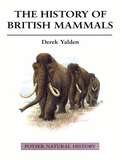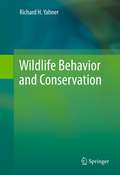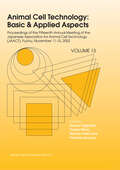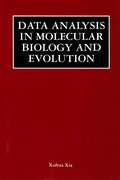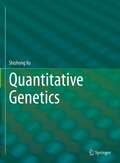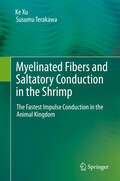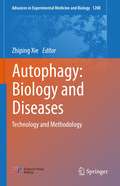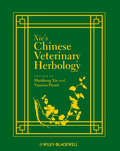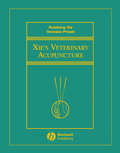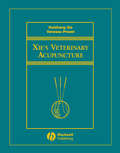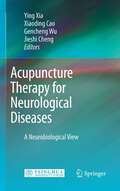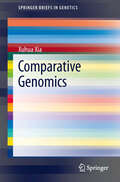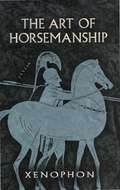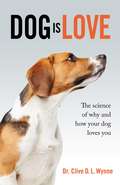- Table View
- List View
The History of British Mammals (Poyser Natural History Ser.)
by Derek Yalden Priscilla BarrettAs ice retreated from Britain 15,000 years ago, a host of large mammals including reindeer, wild horses, wooly mammoths, moose, wolves, brown bears, lynxes and wolverines established itself in Britain. The largest surviving wild land mammal today, the red deer, the largest contemporary land carnivore, the badger and another 65 or so extant wild mammals included about a quarter of the wild mammals that have been introduced in the last 15,000 years. The contemporary fauna, however, is largely dominated by domestic animals, such as cattle, sheep, pigs and humans. This book explores the fate of the large extinct species, as well as how, why, and when the introduced species appeared.
Wildlife Behavior and Conservation
by Richard H. YahnerBegins with in-depth coverage of wildlife behavior concepts as they relate to conservation problems. Topics will focus principally on discussion, critique, and development of behavioral concepts, with particular attention given to published studies on various topics in wildlife behavioral concepts as related to conservation and natural history. He will include an extensive list of references.
Manual of Veterinary Transfusion Medicine and Blood Banking
by Kenichiro Yagi Marie K. HolowaychukUsing a practical approach, the Manual of Veterinary Transfusion Medicine and Blood Banking provides veterinary practitioners with evidence-based guidelines to refer to at the clinical practice level. Provides evidence-based information on transfusion medicine and blood banking practices Presents sections on recipient screening, donor selection, blood collection and storage, and how to meet blood product demands Includes useful protocols for transfusions and blood banking relevant to clinical practice Incorporates the balanced perspectives of veterinarians and veterinary technicians Contains information pertaining to large, small, and exotic animals
Manual of Veterinary Transfusion Medicine and Blood Banking
by Kenichiro Yagi Marie HolowaychukUsing a practical approach, the Manual of Veterinary Transfusion Medicine and Blood Banking provides veterinary practitioners with evidence-based guidelines to refer to at the clinical practice level. Provides evidence-based information on transfusion medicine and blood banking practices Presents sections on recipient screening, donor selection, blood collection and storage, and how to meet blood product demands Includes useful protocols for transfusions and blood banking relevant to clinical practice Incorporates the balanced perspectives of veterinarians and veterinary technicians Contains information pertaining to large, small, and exotic animals
Animal Cell Technology: Proceedings of the Fifteenth Annual Meeting of the Japanese Association for Animal Cell Technology (JAACT), Fuchu, Japan, November 11-15, 2002 (Animal Cell Technology: Basic & Applied Aspects #13)
by Kazumi Yagasaki Yutaka Miura Makoto Hatori Yoshihiro NomuraAnimal cell technology is a growing discipline of cell biology which aims not only to understand structures, functions and behaviors of differentiated animal cells, but also to ascertain their abilities to be used in industrial and medical purposes. The goal of animal cell technology includes accomplishments of clonal expansion of differentiated cells with useful ability, optimization of their culture conditions, modulation of their ability for production of medically and pharmaceutically important proteins and the application of animal cells to gene therapy, artificial organs and functional foods. This volume gives the readers a complete review of present state-of-the-art in Japan and other countries where this field is well advanced. The Proceedings will be useful for the cell biologists, biochemists, molecular biologists, immunologists, biochemical engineers and other disciplines related to animal cell culture, working in either academic environments or in industries of biotechnology and pharmacy.
Data Analysis in Molecular Biology and Evolution
by Xuhua XiaData Analysis in Molecular Biology and Evolution introduces biologists to DAMBE, a proprietary, user-friendly computer program for molecular data analysis. The unique combination of this book and software will allow biologists not only to understand the rationale behind a variety of computational tools in molecular biology and evolution, but also to gain instant access to these tools for use in their laboratories. Data Analysis in Molecular Biology and Evolution serves as an excellent resource for advanced level undergraduates or graduates as well as for professionals working in the field.
Principles of Statistical Genomics
by Shizhong XuStatistical genomics is a rapidly developing field, with more and more people involved in this area. However, a lack of synthetic reference books and textbooks in statistical genomics has become a major hurdle on the development of the field. Although many books have been published recently in bioinformatics, most of them emphasize DNA sequence analysis under a deterministic approach. Principles of Statistical Genomics synthesizes the state-of-the-art statistical methodologies (stochastic approaches) applied to genome study. It facilitates understanding of the statistical models and methods behind the major bioinformatics software packages, which will help researchers choose the optimal algorithm to analyze their data and better interpret the results of their analyses. Understanding existing statistical models and algorithms assists researchers to develop improved statistical methods to extract maximum information from their data. Resourceful and easy to use, Principles of Statistical Genomics is a comprehensive reference for researchers and graduate students studying statistical genomics.
Quantitative Genetics
by Shizhong XuThe intended audience of this textbook are plant and animal breeders, upper-level undergraduate and graduate students in biological and agricultural science majors. Statisticians who are interested in understanding how statistical methods are applied to genetics and agriculture can benefit substantially by reading this book. One characteristic of this textbook is represented by three chapters of technical reviews for Mendelian genetics, population genetics and preliminary statistics, which are prerequisites for studying quantitative genetics. Numerous examples are provided to illustrate different methods of data analysis and estimation of genetic parameters. Along with each example of data analyses is the program code of SAS (statistical analysis system).
Myelinated Fibers and Saltatory Conduction in the Shrimp: The Fastest Impulse Conduction in the Animal Kingdom
by Ke Xu Susumu TerakawaIn 1961, neurobiologists found that the conduction velocity of the nerve impulse in the giant nerve fiber of the Penaeus shrimp abdominal nerve cord was over 200 m/s, the highest speed of information transmission ever observed in the animal kingdom. The peculiar myelin sheath with its unique nodal structure and the electrical properties of the nerve fibers of the shrimp have continued to be investigated for a quarter of century and are now fully described in this book. The investigation dispels the commonly held belief that the fastest recorded impulse conduction is about 120 m/s in the thickest vertebrate myelinated nerve fibers. In the shrimp, researchers found a completely novel type of functional node in the giant fiber which they designated as the fenestration node. In portions of the myelinated fiber, the fenestration node furnished the sites of excitation. Also discovered was a new strategy for increasing impulse conduction in the shrimp. The book includes a section on the formation of the fenestration node and the discovery of a strategy that allows the shrimp to escape its predators by an action of the fastest velocity. The data presented in this volume on the myelin sheath of invertebrates present a new direction for this field and a rich source of information for neurobiologists worldwide.
Autophagy: Technology and Methodology (Advances in Experimental Medicine and Biology #1208)
by Zhiping XieThis book series consists of 3 volumes covering the basic science (Volume 1), clinical science (Volume 2) and the technology and methodology (Volume 3) of autophagy. Volume 3 focuses on the technical aspects of autophagy research. It is comprised of two parts. The first part discusses the basic process of autophagy, including its overall classification and individual stages in the life cycle of autophagosomes. The second part discusses the tools, strategies, and model systems in current autophagy research, including cell and animal models, detection and manipulation methods, as well as screening, genomic, proteomic and bioinformatic approaches. The book is written and edited by a team of active scientists. It is intended as a practical reference resource for interested researchers to get started on autophagy studies.
Xie's Chinese Veterinary Herbology
by Huisheng Xie Vanessa PreastXie's Chinese Veterinary Herbology serves as a practical guide to the theory and application of Chinese Herbal Medicine into veterinary practices. Divided into three parts, the book covers herbal materia medica used in treating various disorders and diseases, herbal formulas, and the clinical application of treatments. The book also outlines each herb's history, the formulation of herbal recipes, energetic actions, indications and contraindications of each formula, dosages, and clinical and pharmacological studies performed with herbal treatments. This text serves as an invaluable reference to veterinarians looking to expand treatment options.
Xie's Chinese Veterinary Herbology
by Huisheng Xie Vanessa PreastXie's Chinese Veterinary Herbology serves as a practical guide to the theory and application of Chinese Herbal Medicine into veterinary practices. Divided into three parts, the book covers herbal materia medica used in treating various disorders and diseases, herbal formulas, and the clinical application of treatments. The book also outlines each herb's history, the formulation of herbal recipes, energetic actions, indications and contraindications of each formula, dosages, and clinical and pharmacological studies performed with herbal treatments. This text serves as an invaluable reference to veterinarians looking to expand treatment options.
Xie's Veterinary Acupuncture
by Huisheng Xie Vanessa PreastTraditional Chinese Veterinary Medicine has been used to treat animals in China for thousands of years. Until now, the majority of the literature on Traditional Chinese Veterinary Medicine has been written in Chinese. Xie's Veterinary Acupuncture serves as a comprehensive and accessible reference on the basic principles, techniques and clinical application of veterinary acupuncture. Written by a world renowned authority on veterinary acupuncture and a panel of experts, the book incorporates a traditional Chinese approach to veterinary acupuncture, including ancient and newly developed acupuncture techniques for both small and large animals. With the growing interest in veterinary acupuncture worldwide, this ground-breaking and authoritative text is a timely resource for practitioners and students alike.
Xie's Veterinary Acupuncture
by Huisheng Xie Vanessa PreastTraditional Chinese Veterinary Medicine has been used to treat animals in China for thousands of years. Until now, the majority of the literature on Traditional Chinese Veterinary Medicine has been written in Chinese. Xie's Veterinary Acupuncture serves as a comprehensive and accessible reference on the basic principles, techniques and clinical application of veterinary acupuncture. Written by a world renowned authority on veterinary acupuncture and a panel of experts, the book incorporates a traditional Chinese approach to veterinary acupuncture, including ancient and newly developed acupuncture techniques for both small and large animals. With the growing interest in veterinary acupuncture worldwide, this ground-breaking and authoritative text is a timely resource for practitioners and students alike.
Acupuncture Therapy for Neurological Diseases: A Neurobiological View
by Ying Xia Xiaoding Cao Cheng Wu Jieshi ChengAcupuncture therapy has been practiced in China and other Asian countries for more than two thousand years. Modern clinical research has confirmed the impressive therapeutic effect of acupuncture on numerous human ailments, such as controlling pain, nausea, and vomiting. However, the biological mechanisms of acupuncture are still under debate. In Traditional Chinese Medicine (TCM), the mechanism of acupuncture therapy is explained by a meridian model. According to this model, acupuncture is believed to treat the diseased organs by modulating two conditions known as Yin and Yang, which represent all the opposite principles that people find in the universe, both inside and outside the human body. Yin and Yang complement each other, and are subjected to changes between each other. The balance of Yin and Yang is thought to be maintained by Qi, an energy substance flowing constantly through the meridian, a network connecting all the organs of the body. The illness, according to this theory, is the temporary dominance of one principle over the other, owing to the blockade of the Qi from flowing through the meridian under certain circumstance. The axiom of “No stagnation, No pain” in TCM summarizes this concept. Thus, the goal of acupuncture treatment is to restore the balance of Yin and Yang conditions in the diseased organ(s). This theory has been considered to be useful to guide this ancient therapy, such as carrying out diagnosis, deciding on the principle, and selecting the acupoints.
Neural Functions of the Delta-Opioid Receptor
by Ying XiaThis book is the first to summarize the progress of research on neural functions of the the delta opioid receptor (DOR) to date. This receptor, a member of the opioid receptor family, was traditionally thought to be primarily involved in pain modulation. Recent new findings have shown its unique role in neuroprotection and many other functions. Many scientists from a number of independent laboratories have now confirmed that DOR can provide neuroprotection against hypoxic/ischemic injuries. They have also found that it plays a role in a variety of physiological and pathophysiological events such as hypoxic encephalopathy, epilepsy, acupuncture, Parkinson's disease, etc. by regulating ionic homeostasis, glutamate transportation and signaling, and balancing intracellular survival/death signals. The book will provide a comprehensive overview of the current state of DOR research and provide a blueprint for future directions.
Comparative Genomics (SpringerBriefs in Genetics)
by Xuhua XiaThis book provides an evolutionary conceptual framework for comparative genomics, with the ultimate objective of understanding the loss and gain of genes during evolution, the interactions among gene products, and the relationship between genotype, phenotype and the environment. The many examples in the book have been carefully chosen from primary research literature based on two criteria: their biological insight and their pedagogical merit. The phylogeny-based comparative methods, involving both continuous and discrete variables, often represent a stumbling block for many students entering the field of comparative genomics. They are numerically illustrated and explained in great detail. The book is intended for researchers new to the field, i.e., advanced undergraduate students, postgraduates and postdoctoral fellows, although professional researchers who are not in the area of comparative genomics will also find the book informative.
The Art of Horsemanship
by Xenophon Morris H. MorganAmong the earliest known works on choosing, caring for, and riding horses, this book is still hailed--2,300 years after it was written — as one of the most complete, thoughtful, and accessible guides of its type. Civilization has changed radically in the centuries since it was written, but the equestrian arts have remained essentially the same. Much of what we presently accept as common wisdom about horsemanship derives from this volume.A student of Socrates, Xenophon was an accomplished cavalryman and one of the foremost scholars of his day. This translation by Morris H. Morgan offers a fluid interpretation of the ancient Greek's advice, plus 38 carefully chosen illustrations. Equestrians and other horse lovers as well as military history buffs and students of Greek culture will find The Art of Horsemanship a treasury of practical tips and enlightened observations.
Cave Biodiversity: Speciation and Diversity of Subterranean Fauna
by J. Judson WynneA deep-dive into the evolutionary biology, biogeography, and conservation of the most elusive subterranean creatures in the world.Far from the austere, sparsely populated ecosystems often conjured in the imagination, caves host some of the most mysterious and biodiverse natural systems in the world. Subterranean environments, however, are the least explored terrestrial habitats, contributing to misconceptions about their inhabitants. Edited by cave scientist and conservation ecologist Dr. J. Judson Wynne, Cave Biodiversity explores both the evolution and the conservation of subterrestrial-dwelling fauna. Covering both vertebrates and invertebrates, including mollusks, fishes, amphibians, arthropods, and other troglobionts, this volume brings together ichthyologists, entomologists, ecologists, herpetologists, and conservationists to provide a nuanced picture of life beneath the earth's surface. Broad chapters covering biotic and abiotic factors that influence evolution and support biodiversity precede chapters dedicated to specific taxa, highlighting phylogenetics and morphology, and delving into zoogeography, habitat, ecology, and dispersal mechanisms for each. Considerations for conservation of these fascinating, often bizarre, and often highly sensitive subterranean creatures are emphasized throughout.Cave Biodiversity aims to synthesize the principles of subterranean evolutionary biology and diversity through in-depth case studies of some of the most captivating and imperiled taxonomic groups in the world. Employing a multidisciplinary approach involving systematics, genetics, ecology, biogeography, evolutionary biology, and conservation science, Cave Biodiversity will be of keen interest to evolutionary biologists, ecologists, conservation biologists, and cave scientists, as well as advanced undergraduate and graduate students. Contributors: Maria E. Bichuette, Evin T. Carter, Prosanta Chakrabarty, Kenneth James Chapin, Danté B. Fenolio, Andrew G. Gluesenkamp, Jozef Grego, Francis G. Howarth, Leonardo Latella, Matthew L. Niemiller, Karen A. Ober, T. Keith Philips, John G. Phillips, Stuart Pimm, Daphne Soares, J. Judson Wynne, and Yahui Zhao.
Cave Biodiversity: Speciation and Diversity of Subterranean Fauna
by J. Judson WynneA deep-dive into the evolutionary biology, biogeography, and conservation of the most elusive subterranean creatures in the world.Far from the austere, sparsely populated ecosystems often conjured in the imagination, caves host some of the most mysterious and biodiverse natural systems in the world. Subterranean environments, however, are the least explored terrestrial habitats, contributing to misconceptions about their inhabitants. Edited by cave scientist and conservation ecologist Dr. J. Judson Wynne, Cave Biodiversity explores both the evolution and the conservation of subterrestrial-dwelling fauna. Covering both vertebrates and invertebrates, including mollusks, fishes, amphibians, arthropods, and other troglobionts, this volume brings together ichthyologists, entomologists, ecologists, herpetologists, and conservationists to provide a nuanced picture of life beneath the earth's surface. Broad chapters covering biotic and abiotic factors that influence evolution and support biodiversity precede chapters dedicated to specific taxa, highlighting phylogenetics and morphology, and delving into zoogeography, habitat, ecology, and dispersal mechanisms for each. Considerations for conservation of these fascinating, often bizarre, and often highly sensitive subterranean creatures are emphasized throughout.Cave Biodiversity aims to synthesize the principles of subterranean evolutionary biology and diversity through in-depth case studies of some of the most captivating and imperiled taxonomic groups in the world. Employing a multidisciplinary approach involving systematics, genetics, ecology, biogeography, evolutionary biology, and conservation science, Cave Biodiversity will be of keen interest to evolutionary biologists, ecologists, conservation biologists, and cave scientists, as well as advanced undergraduate and graduate students. Contributors: Maria E. Bichuette, Evin T. Carter, Prosanta Chakrabarty, Kenneth James Chapin, Danté B. Fenolio, Andrew G. Gluesenkamp, Jozef Grego, Francis G. Howarth, Leonardo Latella, Matthew L. Niemiller, Karen A. Ober, T. Keith Philips, John G. Phillips, Stuart Pimm, Daphne Soares, J. Judson Wynne, and Yahui Zhao.
Do Animals Think?
by Clive D. WynneDoes your dog know when you've had a bad day? Can your cat tell that the coffee pot you left on might start a fire? Could a chimpanzee be trained to program your computer? In this provocative book, noted animal expert Clive Wynne debunks some commonly held notions about our furry friends. It may be romantic to ascribe human qualities to critters, he argues, but it's not very realistic. While animals are by no means dumb, they don't think the same way we do. Contrary to what many popular television shows would have us believe, animals have neither the "theory-of-mind" capabilities that humans have (that is, they are not conscious of what others are thinking) nor the capacity for higher-level reasoning. So, in Wynne's view, when Fido greets your arrival by nudging your leg, he's more apt to be asking for dinner than commiserating with your job stress. That's not to say that animals don't possess remarkable abilities--and Do Animals Think? explores countless examples: there's the honeybee, which not only remembers where it found food but communicates this information to its hivemates through an elaborate dance. And how about the sonar-guided bat, which locates flying insects in the dark of night and devours lunch on the wing? Engagingly written, Do Animals Think? takes aim at the work of such renowned animal rights advocates as Peter Singer and Jane Goodall for falsely humanizing animals. Far from impoverishing our view of the animal kingdom, however, it underscores how the world is richer for having such a diversity of minds--be they of the animal or human variety.
Do Animals Think? (PDF)
by Clive D. WynneDoes your dog know when you've had a bad day? Can your cat tell that the coffee pot you left on might start a fire? Could a chimpanzee be trained to program your computer? In this provocative book, noted animal expert Clive Wynne debunks some commonly held notions about our furry friends. It may be romantic to ascribe human qualities to critters, he argues, but it's not very realistic. While animals are by no means dumb, they don't think the same way we do. Contrary to what many popular television shows would have us believe, animals have neither the "theory-of-mind" capabilities that humans have (that is, they are not conscious of what others are thinking) nor the capacity for higher-level reasoning. So, in Wynne's view, when Fido greets your arrival by nudging your leg, he's more apt to be asking for dinner than commiserating with your job stress. That's not to say that animals don't possess remarkable abilities--and Do Animals Think? explores countless examples: there's the honeybee, which not only remembers where it found food but communicates this information to its hivemates through an elaborate dance. And how about the sonar-guided bat, which locates flying insects in the dark of night and devours lunch on the wing? Engagingly written, Do Animals Think? takes aim at the work of such renowned animal rights advocates as Peter Singer and Jane Goodall for falsely humanizing animals. Far from impoverishing our view of the animal kingdom, however, it underscores how the world is richer for having such a diversity of minds--be they of the animal or human variety.
Dog is Love: The Science of Why and How Your Dog Loves You
by Clive Wynne'Science finally reveals the dog's secret: the unique capacity for love that separates them from all other animals. Superb' - John Bradshaw, bestselling author of In Defence of Dogs and Cat Sense'If you want to build an even stronger bond with your own dog, this book is a must read' - Victoria Stilwell, author of The Secret Language of Dogs'This book will change the way you look at dogs' - Hal Herzog, author of Some We Love, Some We Hate, Some We Eat: Why It's So Hard to Think Straight About Animals_______What makes dogs truly special? Why does our relationship with them feel so much more deep and intense than with other animals?Any dog owner knows that the bond with their dog is unique. The unparalleled loyalty and total devotion of a dog seems the stuff of true love - but is this a whimsical construction that bears little relation to reality? Through ground-breaking scientific experiments and eye-opening historical evidence, canine behavioural psychologist Dr Clive Wynne unlocks the secret to our unique bond with dogs: their capacity to love, an unprecedented attribute in the animal kingdom. In Dog is Love, Dr Wynne debunks the myth that dogs possess a unique form of intelligence. Instead, he shows that dogs are able to show sympathy and can respond to human emotions in a way that is truly remarkable. One particularly moving study shows that dogs' and their owners' hearts beat in synchrony, just as the hearts of a loving human couple do. Looking at the evolution of dogs, Dr Wynne points out that it was the wolves' ability to form relationships with mankind, becoming indispensable hunting companions, that enabled the depth of love and affection between dogs and humans that we know today. Dr Wynne shares his experiences of hunting with the Mayangna tribe in Nicaragua and the vital role played by their hunting dogs to shed light on what the early human-dog relationship might have looked like, and explains the science behind what really goes on when a young pup grows up in a human family. This is a delightful, heart-warming and fascinating analysis of the unique bond between humans and dogs, perfect for anyone who shares their home with their dog and wonders just how much they love you. It will change the way you interact with dogs and help you get the best out of them in a way that will be truly life-changing.
Veterinary Herbal Medicine E-Book
by Susan G. Wynn Barbara FougereThis full-color reference offers practical, evidence-based guidance on using more than 120 medicinal plants, including how to formulate herbal remedies to treat common disease conditions. A body-systems based review explores herbal medicine in context, offering information on toxicology, drug interactions, quality control, and other key topics.More than 120 herbal monographs provide quick access to information on the historical use of the herb in humans and animals, supporting studies, and dosing information. Includes special dosing, pharmacokinetics, and regulatory considerations when using herbs for horses and farm animals. Expanded pharmacology and toxicology chapters provide thorough information on the chemical basis of herbal medicine. Explores the evolutionary relationship between plants and mammals, which is the basis for understanding the unique physiologic effects of herbs. Includes a body systems review of herbal remedies for common disease conditions in both large and small animals. Discusses special considerations for the scientific research of herbs, including complex and individualized interventions that may require special design and nontraditional outcome goals.
